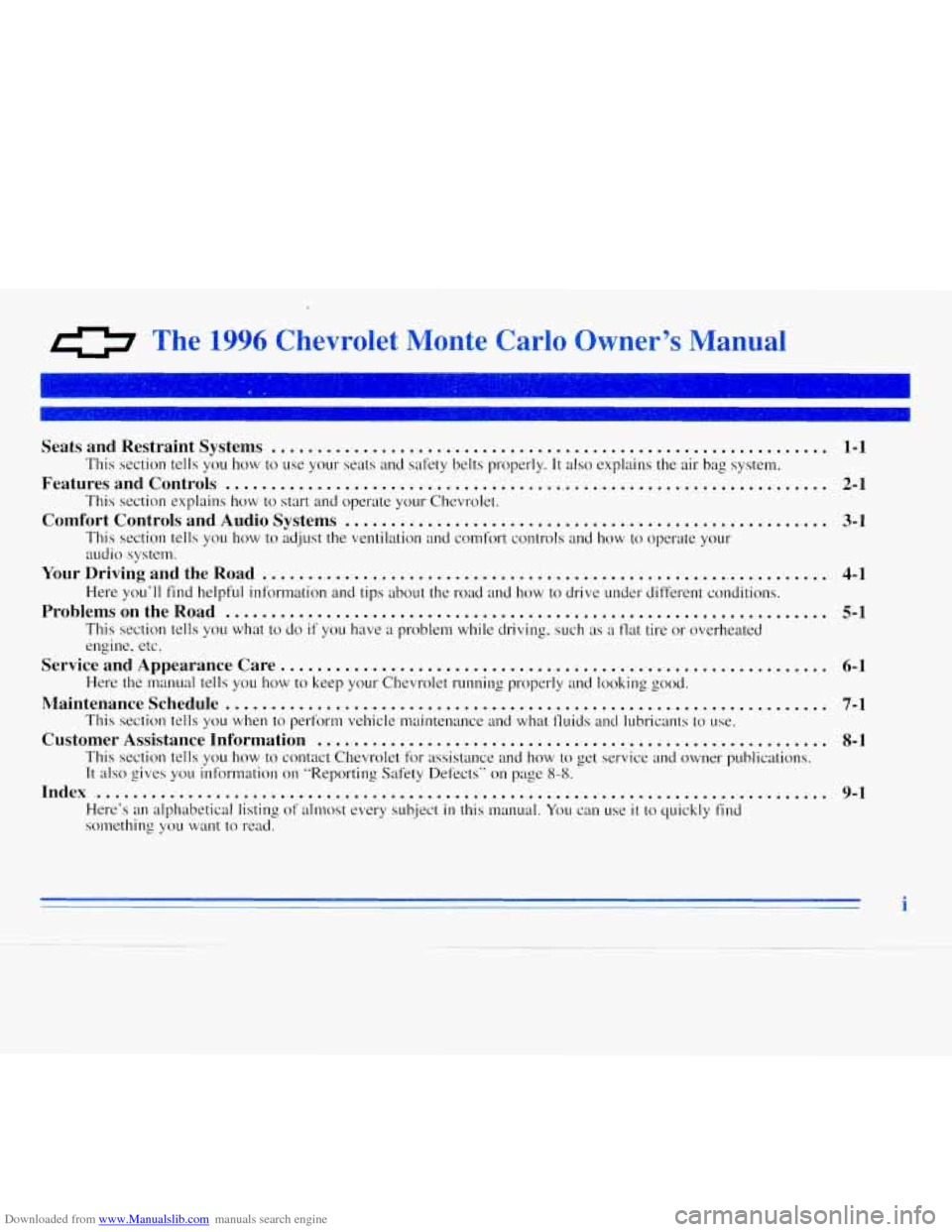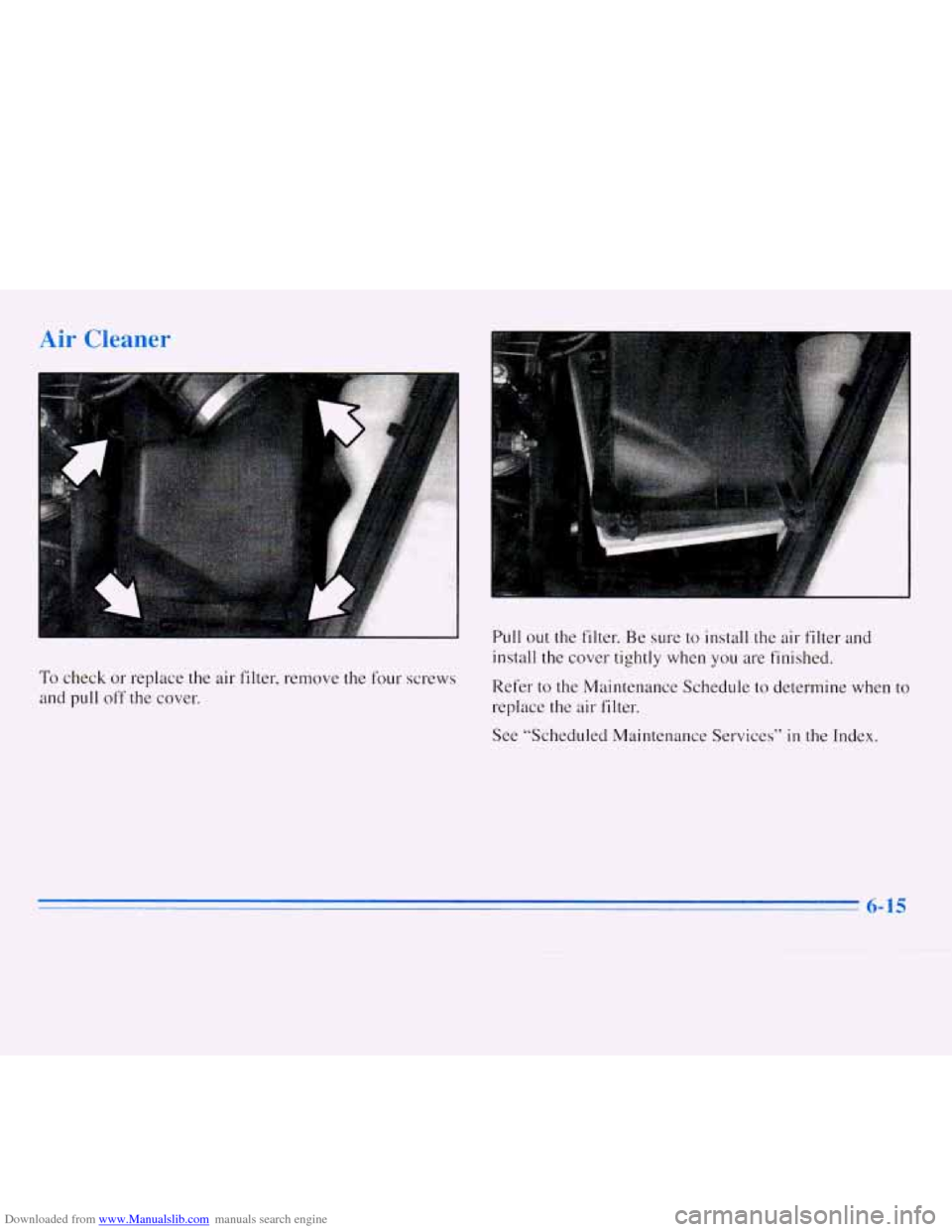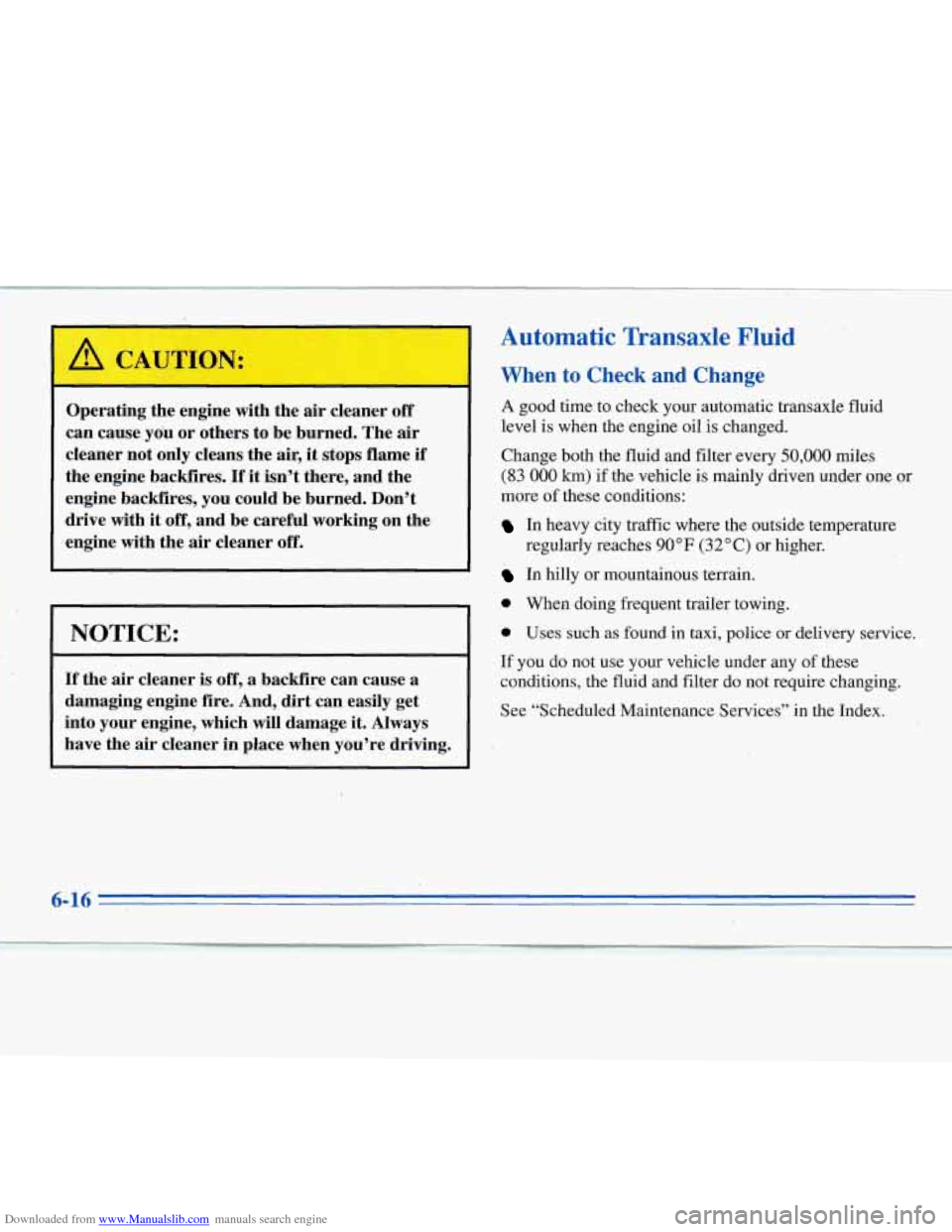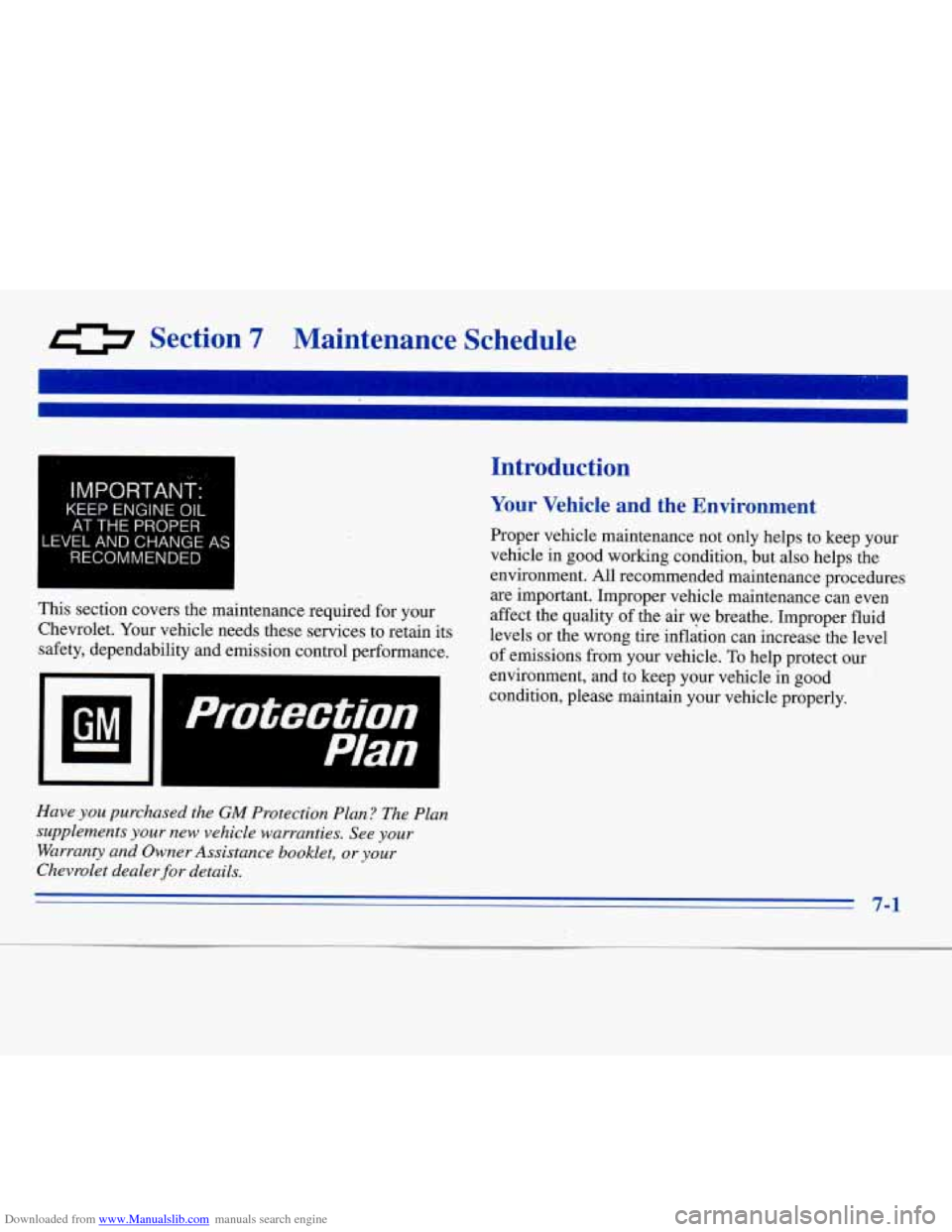1996 CHEVROLET MONTE CARLO maintenance schedule
[x] Cancel search: maintenance schedulePage 3 of 340

Downloaded from www.Manualslib.com manuals search engine d> The 1996 Chevrolet Monte Carlo Owner’s Manual
Seats and Restraint Systems ............................................................. 1-1
Features and Controls
.................................................................. 2-1
Comfort Controls and Audio Systems
..................................................... 3-1
This section tells you how to use your seats and safety belts properly. It also explains the air bag system.
This section explains how
to start and operate your Chevrolet.
This section tells
you how to adjust the ventilation and comfort controls and how lo operate your
audio system.
Here
you’ll find helpful information and tips about the road and how to drive under different conditions.
This section tells you what
to do if you have a problem while driving, such as a tlat tire or overheated
engine, etc.
Here
the manual tells you how to keep your Chevrolet running properly and looking good.
This section tells you when
to perform vehicle maintenance and what fluids and lubricants to use.
This section tells you how
to contact Chevrolet for assistance and how to get service and owner publications.
It also gives you information on “Reporting Safety Defects” on page 8-8.
Index ........................................................................\
........ 9-1
Here‘s an alphabetical listing of almost every subject in this manual. You can use it to quickly find
something you want to read.
YourDrivingandtheRoad .............................................................. 4-1
ProblemsontheRoad .................................................................. 5-1
ServiceandAppearanceCare ............................................................ 6-1
Maintenanceschedule
.................................................................. 7-1
Customer Assistance Information
........................................................ 8-1
i
Page 170 of 340

Downloaded from www.Manualslib.com manuals search engine Parking on Hills
You really should not park your vehicle, with a trailer
attached, on a
hill. If something goes wrong, your rig
could start to move. People can be injured, and both
your vehicle and the trailer can be damaged.
But if you ever have to park your rig on a hill, here’s
how to do
it:
1.
2.
3.
4.
5.
Apply your regular brakes, but don’t shift into
PARK (P)
yet.
Have someone place chocks under the trailer wheels.
When the wheel chocks are in place, release the
regular brakes
until the chocks absorb the load.
Reapply the regular brakes.
Then apply your parking
brake, and then shift
to PARK (P).
Release the regular brakes.
When You Are Ready to Leave After
Parking
on a Hill
1. Apply your regular brakes and hold the pedal down
while
you:
Start your engine;
Shift into a gear; and
Release the parking brake.
2. Let up on the brake pedal.
3. Drive slowly until the trailer is clear of the chocks.
4. Stop and have someone pick up and store the chocks.
Maintenance When Trailer Towing
Your vehicle will need service more often when you’re
pulling
a trailer. See the Maintenance Schedule for more
on this. Things that are especially important
in trailer
operation are automatic transaxle fluid (don’t overfill),
engine oil, belts, cooling system and brake adjustment.
Each of these is covered
in this manual, and the Index
will help you find them quickly. If you’re trailering, it’s
a good idea to review these sections before you start
your trip.
Check periodically to
see that all hitch nuts and bolts
are tight.
Page 223 of 340

Downloaded from www.Manualslib.com manuals search engine Air Cleaner
To check or replace the air filter, remove the four screws
and pull
off the cover. Pull
out the filter. Be sure to install the air filter and
install the cover tightly when you are finished.
Refer to the Maintenance Schedule to determine when to
replace the air filter.
See “Scheduled Maintenance Services”
in the Index.
6-15
Page 224 of 340

Downloaded from www.Manualslib.com manuals search engine -
,A CAUTION:
Operating the engine with the air cleaner off
can cause you or others to be burned. The air
cleaner not only cleans the air, it stops flame if
the engine backfires. If it isn’t there, and the
engine backfires, you could be burned. Don’t
drive with
it off, and be careful working on the
engine with the
air cleaner off.
NOTICE:
If the air cleaner is off, a backfire can cause a
damaging engine fire. And, dirt can easily get
into your engine, which will damage it. Always
have the air cleaner in place when you’re driving.
Automatic Transaxle Fluid
When to Check and Change
A good time to check your automatic transaxle fluid
level is when the engine oil is changed.
Change both the fluid and filter every
50,000 miles
(83 000 km) if the vehicle is mainly driven under one or
more
of these conditions:
In heavy city traffic where the outside temperature
In hilly or mountainous terrain.
0 When doing frequent trailer towing.
0 Uses such as found in taxi, police or delivery service.
If you do not use your vehicle under any of these
conditions, the fluid and filter do not require changing.
See “Scheduled Maintenance Services’’ in the Index.
regularly reaches
90°F (32°C) or
higher.
6-16 .
Page 227 of 340

Downloaded from www.Manualslib.com manuals search engine How to Add Fluid Engine Coolant
Refer to the Maintenance Schedule to determine what
kind
of transaxle fluid to use. See “Recommended
Fluids and Lubricants”
in the Index.
If the fluid
level is low, add only enough of the proper
fluid to bring the level into the cross-hatched area on
the dipstick.
1. Pull out the dipstick.
2. Using a long-neck funnel, add enough fluid at the
dipstick hole to bring
it to the proper level. It doesn’t
take much fluid, generally less than
a pint (OSL).
Don ’t overfill. We recommend you use only fluid
labeled DEXRON@-111, because fluid with that
label is made especially for your automatic transaxle.
Damage caused by fluid other than DEXRON@-I11
is
not covered by your new vehicle warranty.
0 After adding fluid, recheck the fluid level as
described under “How to Check.”
0 When the correct fluid level is obtained, push the
dipstick back
in all the way. The cooling
system in your vehicle is filled with new
DEX-COOL
TM (orange-colored, silicate-free) engine
coolant. This coolant is designed
to remain in your
vehicle for
5 years or 100,000 miles ( 166 000 km),
whichever occurs first.
The following explains your cooling system and how
to
add coolant when it is low. If you have a problem with
engine overheating
or if you need to add coolant to your
radiator, see “Engine Overheating”
in the Index.
A 50/50 mixture of water and the proper coolant for
your Chevrolet will:
0 Give freezing protection down to -34°F (-37°C).
0 Give boiling protection up to 265°F (129°C).
Protect against rust and corrosion.
0 Help keep the proper engine temperature.
0 Let the warning lights and gages work as they
should.
Page 232 of 340

Downloaded from www.Manualslib.com manuals search engine How To Check Power Steering Fluid Windshield Washer Fluid
When the engine compartment is cool, unscrew the cap
and wipe the dipstick with a clean rag. Replace the cap
and completely tighten it. Then remove the cap, again
and look at the fluid level on the dipstick.
When the engine
compartment is hot, the
What to Use
Refer to the Maintenance Schedule to determine what
kind of fluid to use. See “Recommended Fluids and
Lubricants” in the Index. Always use the proper fluid.
Failure to use the proper fluid can cause leaks and
damage hoses and seals.
What to Use
When you need windshield washer fluid, be sure to read
the manufacturer’s instructions before use. If you will be
operating your vehicle
in an area where the temperature
may fall below freezing, use a fluid that has sufficient
protection against freezing.
Adding Washer Fluid
Open the cap labeled WASHER FLUID OmY. Add
washer fluid until the tank is full.
Page 246 of 340

Downloaded from www.Manualslib.com manuals search engine When to Check
Check your tires once a month or more.
Don’t forget your compact spare tire. It should be at
60 psi (420 kPa).
How to Check
Use a good quality pocket-type gage to check tire
pressure. You can’t tell if your tires are properly inflated
simply by looking at them. Radial tires may look
properly ‘inflated
even when they’re underinflated.
Be sure to put the valve caps back
on the valve stems.
They help prevent leaks by keeping out dirt and moisture.
Tire Inspection and Rotation
Tires should be inspected every 6,000 to 8,000 miles
(10 000 to 13 000 km) for any signs of unusual wear.
If unusual wear is present, rotate your tires as soon as
possible and check wheel alignment. Also check for
damaged tires
or wheels. See “When It’s Time for New
Tires’’ and “Wheel Replacement” later in this section for
more information. The purpose
of regular rotation
is to achieve more
uniform wear for
all tires on the vehicle. The kt
rotation is tlle most important. See “Scheduled
Maintenance Services”
in the Index for scheduled
rotation intervals.
Whcn rotating your tires,
always use the correct rotation
pattern
shown here.
Don’t include the compact spare tire
in your tire rotation.
u-30
Page 273 of 340

Downloaded from www.Manualslib.com manuals search engine 0 Section 7 Maintenance Schedule
IMPORTANT:"
KEEP ENGINE OIL
AT THE
PROPER
-EVEL AND CHANGE AS
RECOMMENDED
I
Introduction
Your Vehicle and the Environment
Proper vehicle maintenance not only h,elps to keep your
vehicle in good working condition, but also helps the
environment.
All recommended maintenance procedures
are important. Improper vehicle maintenance can even
This section covers the maintenance required for your affect
the quality of the air we breathe. Improper fluid
Chevrolet. Your vehicle needs these services to retain its
levels or the wrong tire inflation can increase the level
safety, dependability and emission control performance.
of emissions from your vehicle. TO help protect our
environment, and to keep your vehicle in good
condition, please maintain your vehicle properly.
protection Plan I
Have you purchased the GM Protection Plan ? The Plan
supplements
your new vehicle warranties. See your
Warranty and Owner Assistance booklet, or your
Chevrolet dealer for details.
7-1